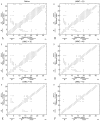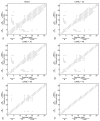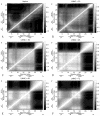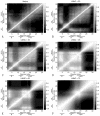Stability and folding behavior analysis of zinc-finger using simple models
- PMID: 21152317
- PMCID: PMC2996801
- DOI: 10.3390/ijms11104014
Stability and folding behavior analysis of zinc-finger using simple models
Abstract
Zinc-fingers play crucial roles in regulating gene expression and mediating protein-protein interactions. In this article, two different proteins (Sp1f2 and FSD-1) are investigated using the Gaussian network model and anisotropy elastic network model. By using these simple coarse-grained methods, we analyze the structural stabilization and establish the unfolding pathway of the two different proteins, in good agreement with related experimental and molecular dynamics simulation data. From the analysis, it is also found that the folding process of the zinc-finger motif is predominated by several factors. Both the zinc ion and C-terminal loop affect the folding pathway of the zinc-finger motif. Knowledge about the stability and folding behavior of zinc-fingers may help in understanding the folding mechanisms of the zinc-finger motif and in designing new zinc-fingers. Meanwhile, these simple coarse-grained analyses can be used as a general and quick method for mechanistic studies of metalloproteins.
Keywords: FSD-1; Gaussian network model; Sp1f2; anisotropy elastic network model; folding pathway; zinc finger.
Figures











Similar articles
-
Understanding the folding and stability of a zinc finger-based full sequence design protein with replica exchange molecular dynamics simulations.Proteins. 2007 May 1;67(2):338-49. doi: 10.1002/prot.21312. Proteins. 2007. PMID: 17285627
-
C-terminal in Sp1-like artificial zinc-finger proteins plays crucial roles in determining their DNA binding affinity.BMC Biotechnol. 2013 Dec 1;13:106. doi: 10.1186/1472-6750-13-106. BMC Biotechnol. 2013. PMID: 24289163 Free PMC article.
-
GFP-linked zinc finger protein sp1. fluorescence study and implication for N-terminal zinc finger 1 as hinge finger.Bioorg Med Chem. 2003 Jan 2;11(1):53-8. doi: 10.1016/s0968-0896(02)00337-1. Bioorg Med Chem. 2003. PMID: 12467707
-
Designer zinc finger proteins: tools for creating artificial DNA-binding functional proteins.Acc Chem Res. 2006 Jan;39(1):45-52. doi: 10.1021/ar050158u. Acc Chem Res. 2006. PMID: 16411739 Review.
-
Sp1 and its likes: biochemical and functional predictions for a growing family of zinc finger transcription factors.Ann N Y Acad Sci. 1999 Jun 30;880:94-102. doi: 10.1111/j.1749-6632.1999.tb09513.x. Ann N Y Acad Sci. 1999. PMID: 10415854 Review.
Cited by
-
Unveiling the N-Terminal Homodimerization of BCL11B by Hybrid Solvent Replica-Exchange Simulations.Int J Mol Sci. 2021 Mar 31;22(7):3650. doi: 10.3390/ijms22073650. Int J Mol Sci. 2021. PMID: 33807484 Free PMC article.
-
Nuclear localization signal region in nuclear receptor PXR governs the receptor association with mitotic chromatin.Chromosome Res. 2018 Dec;26(4):255-276. doi: 10.1007/s10577-018-9583-2. Epub 2018 Jul 15. Chromosome Res. 2018. PMID: 30009337
-
Resolving the zinc binding capacity of honey bee vitellogenin and locating its putative binding sites.Insect Mol Biol. 2022 Dec;31(6):810-820. doi: 10.1111/imb.12807. Epub 2022 Aug 23. Insect Mol Biol. 2022. PMID: 36054587 Free PMC article.
-
The zinc finger motif in the mitochondrial large ribosomal subunit protein bL36m is essential for optimal yeast mitoribosome assembly and function.Biochim Biophys Acta Mol Cell Res. 2024 Apr;1871(4):119707. doi: 10.1016/j.bbamcr.2024.119707. Epub 2024 Mar 16. Biochim Biophys Acta Mol Cell Res. 2024. PMID: 38493895 Free PMC article.
-
Understanding the molecular mechanism of pathogenic variants of BIR2 domain in XIAP-deficient inflammatory bowel disease.Sci Rep. 2024 Jan 9;14(1):853. doi: 10.1038/s41598-023-50932-5. Sci Rep. 2024. PMID: 38191507 Free PMC article.
References
Publication types
MeSH terms
Substances
LinkOut - more resources
Full Text Sources

